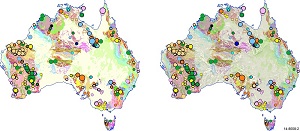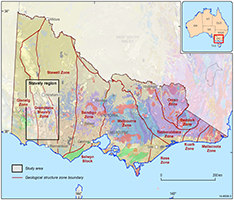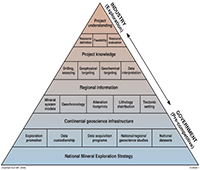News
The role of government geoscience in the minerals industry
Published:24 September 2014
The role of government geoscience in the minerals industry
Australia's mineral resources are an important component of the nation's wealth, both economically and socially. Governments across Australia recognise the challenges facing the minerals industry in continuing to make the discoveries essential to the success of the industry and health of the economy.
Dr James Johnson
This Insights article is an overview of the keynote presentation by Geoscience Australia's Deputy Chief Executive Officer Dr Johnson at the 2014 International Mining and Resources Conference taking place in Melbourne.
Australia's mineral resources are an important component of the nation's wealth, both economically and socially. Governments across Australia recognise the challenges facing the minerals industry in continuing to make the discoveries essential to the success of the industry and health of the economy. Significant resources are being devoted across all levels of government to provide the minerals industry with timely high-quality pre-competitive data and information to underpin and enhance 'greenfield' exploration programs.
A particular interest of governments is to stimulate mineral exploration in the vast greenfield regions that remain under-explored across the country. Notwithstanding more than 200 years of activity, it is estimated that up to 80 per cent of Australia remains under-explored. It is in these regions that the next giant discoveries, such as Mount Isa, Broken Hill, Olympic Dam or Kalgoorlie, may be waiting to be made.
In Australia, the number of discoveries of large ore deposits has decreased over the last 10 years. This has led to a misconception that Australia is mature in relation to mineral exploration and discovery. Part of this perception arises because much of Australia's prospective geology is concealed beneath the cover of younger sediments.
There are technical challenges associated with greenfield exploration, mainly related to the greater depths that may be necessary to explore in order to make the discoveries. There is every reason to believe that much of Australia's greenfield regions is as prospective as those areas where mineral exploration and mining activities have already proved successful.
A steady stream of new projects is essential to maintaining a strong minerals industry and healthy economy. In a competitive world, the challenge is to continue to attract the investment needed to sustain the sector. Through the custodianship and provision of geoscientific data and information, Australia's Federal, State and Territory geological surveys are a key component of Australian governments' response to this challenge.
Pre-competitive geoscience and mineral exploration
Federal, State and Territory government investment over the past 60 years, often enhanced by industry co-funding, has focused on mapping Australia's geology and acquiring a variety of geophysical and geochemical datasets. These continent-scale baseline datasets support exploration for mineral deposits. These are living datasets, continually being added to and improved through targeted data acquisition, available at no cost from Geoscience Australia and the State and Territory geological surveys' websites. These data assists industry identify areas with more favourable mineral potential and helps attract private sector exploration investment in frontier areas.
Mineral exploration outcomes are maximised when government and industry work together toward shared goals (refer Figure 1). Governments' role is to take a comprehensive view by providing a big-picture geological framework view of the continent, acquiring pre-competitive data and developing new concepts to help build a national geoscience knowledge base or 'infrastructure' that highlights areas of enhanced mineral potential.
Role of partnerships
In Australia, partnerships between government, industry and academia have developed over many years through a range of formal and informal mechanisms. The national geology and geophysical datasets developed by Geoscience Australia are examples of such partnerships in action (refer Figure 2). It is fortunate that the key sectors in the geosciences are willing to work together to address identified technical challenges and increase the return on public and private sector investment.

Figure 2. National geology and geophysical datasets showing
areas of mineral potential under sediment cover.
The Australian Academy of Science's UNCOVER Initiative demonstrates the benefits of partnerships in action. This program aims to use the collaborative efforts of Australia's world-class geoscience expertise to build a new vision for mineral exploration in Australia.

Figure 3. Geological map of Victoria
showing the structural geological zones
of Victoria, highlighting the Stavely region.
Adapted from Geological Survey of Victoria.
An excellent example of this is recent work in the Stavely region of western Victoria undertaken by Geoscience Australia in partnership with the Geological Survey of Victoria and the Deep Exploration Technologies Cooperative Research Centre (DET CRC). Understanding the geological structure of this region is crucial to understanding its geodynamic evolution and associated mineral potential.
Geological Survey of Victoria mapping has suggested that the state geology can be divided into a number of structural zones (refer Figure 3) and has led to the proposal of a range of tectonic models for how this structure may have developed over geological time. Through a partnership between the Commonwealth, the State and the DET CRC, a new stratigraphic drilling program to sample basement rocks below cover has begun to test these models in prospective areas.
Facilitating best-practice data stewardship
The usefulness of government geoscience data and information is significantly enhanced when it is properly managed and readily discoverable and accessible. For this reason, a crucial allied role of government is that of data custodian.
This data stewardship role led by Geoscience Australia facilitates the capture of exploration data in open file reports so that previous work can be built on and ensures the proper management, security and reliability of the data. It also allows for centralised data warehousing and accessibility, facilitates company engagement in data collection and supports the use of industry-accepted data standards.
Conclusion
The role of government geoscience in supporting the minerals industry is multi-faceted. It provides national baseline datasets, new ideas and new methods; it facilitates partnerships and plays a key role in data custodianship. In so doing, government geoscience boosts industry confidence in mineral exploration by reducing technical risks and aims to attract investment to under-explored regions in Australia.
It is important to remember that, as well as helping to build resource wealth, a national geoscience infrastructure is also a powerful platform for providing strategic advice and information on a range of other nationally important matters such as water resources, community safety, managing marine jurisdictions and providing fundamental geographic information about the country.
Further information
Contact:
Phone:
Email:





